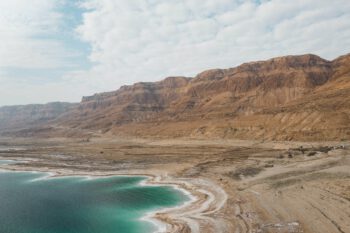The shore of the Dead Sea On August 5th, 2025, environmental experts from Israel, Jordan, and the Palestinian territories descended upon the University of Leeds for a three-day event centered around the Dead Sea and its irreversible decline. The gathering highlighted the urgency and attention that the region directs towards the Dead Sea. Once spanning […]
The post Sinkholes and Shrinking Shores: The Race to Rescue the Dead Sea appeared first on Green Prophet.
The shore of the Dead Sea
On August 5th, 2025, environmental experts from Israel, Jordan, and the Palestinian territories descended upon the University of Leeds for a three-day event centered around the Dead Sea and its irreversible decline. The gathering highlighted the urgency and attention that the region directs towards the Dead Sea.
Once spanning over 400 square miles, the Dead Sea now covers approximately 230 square miles. Currently, the Dead Sea’s water is dropping 3.3 feet per year due to the diversion of the Jordan River and the overextraction of the sea’s minerals.
See Related Article: Environmentalist: “Explore Alternatives to Red-Dead Canal Project”
The area surrounding the sea has changed drastically in the past half-century. Landscapes are riddled with sinkholes, human activity, and leftover mineral deposits.
Overhead image of the Dead Sea
The Dead Sea’s rapid decline is not only an aesthetic decline but also one that affects various aspects of the world. First, it affects ecosystems and biodiversity. All parts of the natural world are connected, and something as prominent as the Dead Sea being destroyed will affect life around it. Also, local communities and infrastructure must be altered and changed due to the new sea levels and sinkholes caused by the decline. The region surrounding the sea is also a tourism hotspot, and if the Dead Sea becomes an undesirable location, the people will stop coming. Finally, the Dead Sea and its resources are not only Israel’s. Jordan and the Palestinian territories also utilize the Dead Sea. A destroyed Dead Sea would increase political tensions due to each country being negatively impacted.
See Related Article: How EcoPeace Uses Environmental Education to Bridge Borders in the Jordan Valley
The summit, held at Leeds, brings together various actors. Israelis, Jordanians, and Palestinians represent the regional interest, and participants from the UK and other Western countries participated to assist. The talks that they had were aimed at discussing improving and creating coordinated and interconnected action.
There have been efforts to save the Dead Sea. The Jordan River is the sea’s water source. However, now only 10% of the original water flow reaches the basin. A key effort in reviving the Dead Sea is to stop the diversion of the river’s water and allow it to flow to the Dead Sea. Additionally, there are regulations on mineral extraction and building. At the Leeds conference, many new ideas were created and shared. Water sharing frameworks, combined with river restoration efforts, re-zoning, desalination brine water, and international funding, provide help. These efforts and efforts of the future also provide an avenue for increased regional stability. Israel and Jordan both use the sea for its resources and the tourism aspect. However, there is minimal cooperation between the countries, leading to an increased decline of the sea. If the countries strengthen, add new efforts, and rely on each other more than it would cause there to be more needed cooperation.
Salt in the Dead Sea
The Dead Sea’s rapid collapse is a tragedy not only for Israel but for the region as a whole. It also tests whether environmental necessity can lead to regional stability. The Leed summit is one of the many conversations currently being had to try to save the sea. Conversations are one thing; action is another, and action is needed to save the Dead Sea.
The post Sinkholes and Shrinking Shores: The Race to Rescue the Dead Sea appeared first on Green Prophet.




